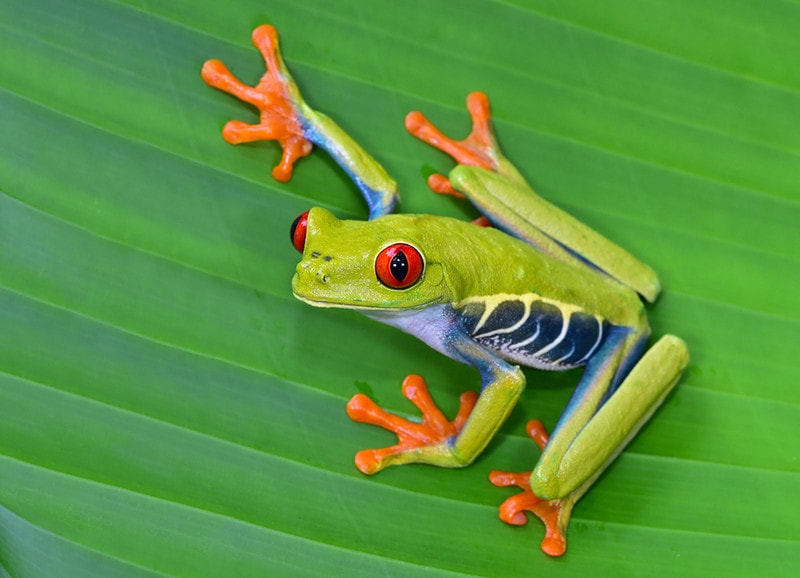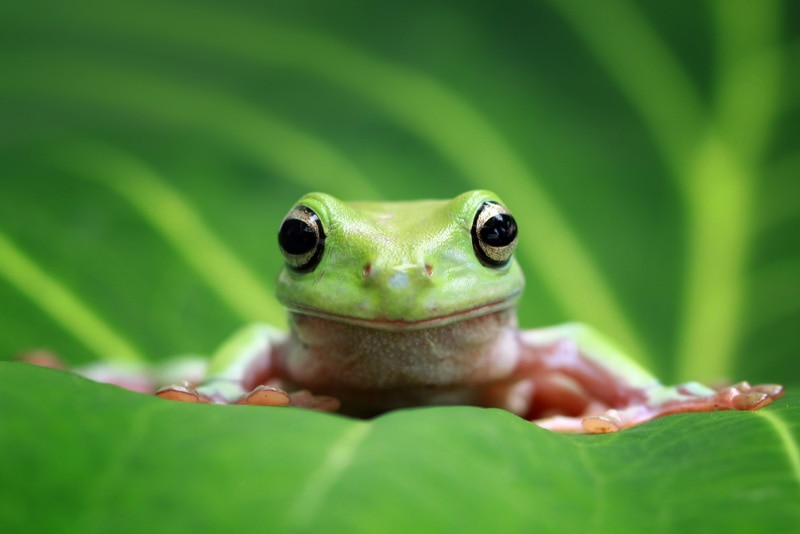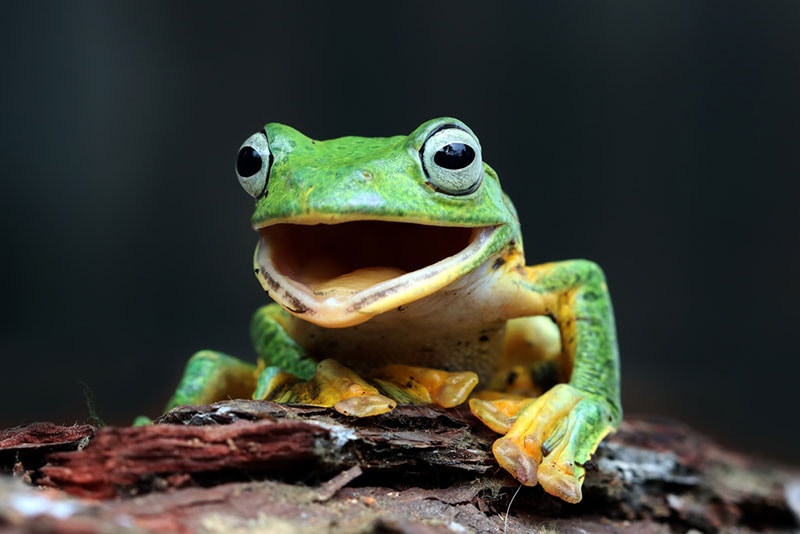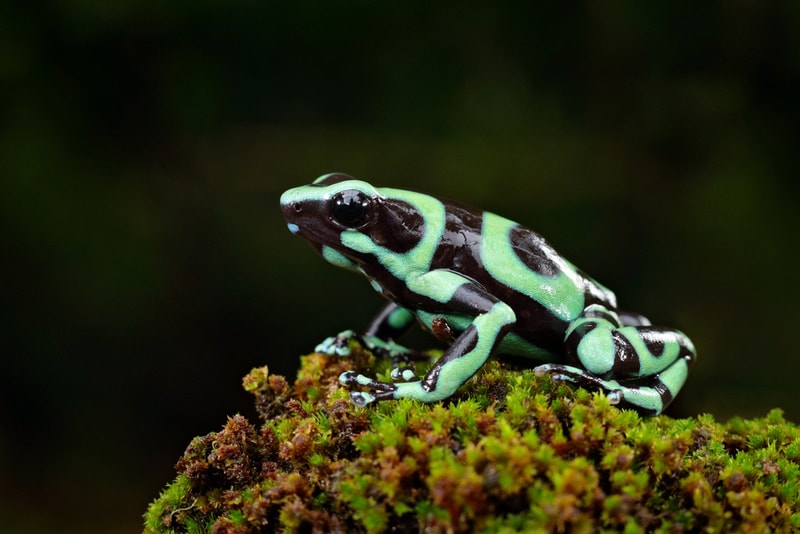Red-Eyed Tree Frog: Lifespan, Diet, Pictures & Care Guide
By Cheryl Regan
Updated on

Click to Skip Ahead
A master at hiding and tree-climbing, the red-eyed tree frog is a stunning, sometimes kaleidoscopic creature that can be a joy to care for. These little frogs change color depending on their mood and environment, but their mesmerizing eyes always remain a glowing shade of red.
Thinking of adopting this amazing amphibian? In this guide, we’ll cover everything you need to know about the red-eyed tree frog, including their lifespan, diet, habitat requirements, and more!
Species Overview
| Size: | Up to 3 inches long |
| Lifespan: | 8 – 12 years |
| Color: | Lime green with hints of yellow or blue. They can become dark green or reddish-brown according to their mood |
| Suitable for: | Intermediate to experienced reptile owners |
| Temperament: | Shy during the day, active at night |
| Diet: | Carnivorous, brown and black crickets, hoppers, mealworms |
| Tank Set Up: | Glass vivarium with moist, coarse orchid bark, a small amount of moss, wood ornaments for perching, live or artificial plants |
| Minimum Tank Size: | 18 inches in length, 24 inches in height |
| Suitable Tank Mates: | Red-eyed tree frogs, other arboreal species like gray tree frogs and white-lipped tree frogs |
It’s easy to see why people fall in love with the red-eyed tree frog’s vibrant eyes and beautiful coloration, but their unique appearance isn’t their only lovable trait. These arboreal creatures pack big personalities into their tiny bodies. Their ability to climb glass walls and decorations alike provides endless entertainment for pet enthusiasts!
Red-Eyed Tree Frog Characteristics
Red-Eyed Tree Frog Overview
The red-eyed tree frog, known scientifically as Agalychnis callidryas, is native to the humid neotropical regions of Central and South America. These nocturnal creatures spend most of their lives in lush rainforests, often close to ponds and other small bodies of fresh water they need for breeding and living.
As beautiful and fascinating as these creatures may seem, their unique and striking red eyes and vibrant green coloring serve a far greater purpose than to entertain us humans—their unique traits help them survive in the wild. When these tiny frogs suddenly open their eyes to reveal two bulging red eyes, it serves to startle oncoming predators. During the day, these frogs often find solace clinging to the underside of foliage, where their green coloring helps them camouflage.
Aside from their looks, red-eyed tree frogs have highly specialized toe pads that help them with their remarkable climbing prowess. In the wild, they climb tall trees and trailing plants, so providing them with a tall vivarium in captivity is also important.
As pets, these little frogs have captured the hearts of reptile enthusiasts the world over. They’re a relatively low-maintenance pet, and their small size means they don’t take up too much space. This, combined with their entertaining behavior, characteristics, and stunning looks, have made them an increasingly popular choice for a pet.

Red-Eyed Tree Frog Cost
Thanks to their popularity, red-eyed tree frogs are widely available and shouldn’t cost too much to purchase from reptile breeders across the United States. However, you should also consider the cost of buying and setting up a vivarium and ongoing expenses, such as food and veterinary care.
After the initial set-up costs, you should be able to care for a single red-eyed tree frog for no more than $25 per month on average. If your frog needs extra veterinary care or their vivarium is damaged or needs replacing, the costs can quickly rise.
Care Guide & Tank Set Up
Although they are relatively low-maintenance and easy to look after, red-eyed tree frogs have very specific needs. For example, they require an environment with a base humidity of 60–75%. This may make them more suitable for intermediate or experienced reptile owners. However, as long as you do your homework first, you should be able to provide a safe and happy environment for a red-eyed tree frog, even if it’s your first amphibian!
Tank Size
As their name suggests, red-eyed tree frogs are arboreal frogs. They love climbing the tall trees in the rainforest, often only stopping when they get into the canopy, where they can be far away from the predators on the forest ground and where insects make an abundantly available food source.
Though it’s impossible—for most people—to provide red-eyed tree frogs with large-sized trees at home, it’s vital to house them in a vivarium that’s tall enough to allow them to act out their natural climbing instincts.
For a single red-eyed tree frog, you’ll need a vivarium that is at least 24 inches tall. You’ll also need to give your frog plenty of places to hide and move around, so we recommend that the vivarium be at least 18 inches long. If you plan on housing more than one frog, you’ll need to get a much larger vivarium.
Substrate
Red-eyed tree frogs need a substrate that remains moist without attracting mold or bacteria. Coir fiber husk (coconut fiber) and orchid bark both work well. You can cover the substrate with a layer of sphagnum moss to help retain moisture even better.
Despite their need for humidity and moisture in the air, there shouldn’t be any standing water on the substrate or bedding.

Humidity
Red-eyed tree frogs need a moderate to high humidity level in their vivarium. Keep a hydrometer in the tank to help you continuously monitor humidity. Ideally, your pet frog’s environment should have a 60–75% base humidity.
You can achieve this humidity level by keeping a small bowl of dechlorinated water in the tank, misting the tank with distilled water once or twice daily, and keeping the substrate damp.
Lighting
As nocturnal creatures living in dense rainforests, red-eyed tree frogs do not get much sunlight in the wild, but they still need the right amount of UVB to maintain healthy bones. Installing a low-wattage UVB light can help simulate natural day and night times for your frog, provide warmth, and help to increase their appetite.
If you are using a light-emitting bulb, make sure to install a dense canopy to filter out most of the direct light.
Heating
The optimal daytime temperatures for a red-eyed tree frog are between 75 and 85°F. The temperature can safely drop to around 70°F at night, though for smaller frogs, it’s safer to remain on the warmer side of the acceptable range.
You can use a heat mat on the back or the side of the glass vivarium, but not on the bottom. You can use a thermostat to ensure the tank remains at the right temperature, but you should also install a thermometer that you can keep an eye on.
Things to Know When Owning a Red-Eyed Tree Frog:
Food & Diet Requirements
Red-eyed tree frogs feed on a protein-rich diet of insects. You’ll need to give them a live food diet consisting mainly of crickets, but you can also occasionally treat them with a variety of insects, including mealworms, waxworms, and CalciWorms.
Water Requirements
These frogs stay hydrated by drinking and absorbing water through their skin. Although they aren’t likely to remain in the water for long periods, you should keep a shallow bowl of dechlorinated water in the tank.
Your frog may go to the toilet in the water, so you’ll need to replace it regularly to keep it clean.\

Lifespan and Health Conditions
As far as pets in captivity go, red-eyed tree frogs generally have an excellent lifespan, with an average frog living to around 10 years. These frogs are generally relatively healthy, with most health issues usually due to unclean habitats, stress, or improper nutrition.
Red Leg Disease
Characterized by the reddening of the frog’s thighs and belly skin, red leg disease is a widespread infection. It’s usually caused by a parasite, Aeromonas hydrophila, resulting in signs including lethargy and weight loss. Red leg disease can usually be treated with antibiotics prescribed by your veterinarian.
Metabolic Bone Disease (MBD)
This disease is usually caused by a lack of proper nutrition, usually vitamin D and calcium. Signs include lethargy and loss of appetite, and the red-eyed tree frog will also stop jumping as the disease affects their bones. If detected early, MBD can be easily cured by feeding your frog vitamin and calcium supplements.
Oodinium
One of the most common red-eyed tree frog health conditions, oodinium, results in small white or gray spots spreading over the frog’s skin. It is usually caused by unclean habitats and can be easily treated by placing the frog into clean distilled water and thoroughly cleaning the tank.
Male vs Female
There’s not much difference between male and female red-eyed tree frogs. If you look closely, you’ll notice that females grow to become bigger and bulkier than males. While male red-eyed tree frogs grow to around 2 inches, females can grow up to 3 inches.
You may also be able to identify nuptial pads on the males—they appear as brown thumbs on each foot pad.
3 Little-Known Facts About the Red-Eyed Tree Frog
1. Their moods affect their color.
Red-eyed tree frogs change color according to their moods!
2. They use their eye colors to distract predators.
These amazing amphibians use their striking red eyes and the element of surprise to dazzle and startle predators, giving the little frogs a chance to hop to safety.
3. They create vibrations to ward off other males nearby.
To mark their territory, male red-eyed tree frogs begin to shake vigorously, creating vibrations that travel for up to 2 meters in distance and warning competing males of their presence.

Final Thoughts
If you’re looking for a fun and interesting pet to take care of, the red-eyed tree frog can be a joy to keep. These little beauties don’t need a lot of space, and as long as their tank is set up right, they’re low maintenance too.
If you’re thinking of bringing home a red-eyed tree frog, make sure you have a tall enough vivarium so your little companion can climb to their heart’s content. Keep their homes warm and moist, and they’ll be sure to keep you entertained with their dazzling beauty and climbing prowess!
Featured Image Credit: worldswildlifewonders, Shutterstock










